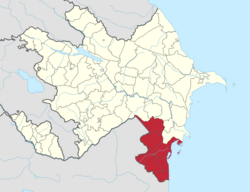This is an old revision of this page, as edited by Grandmaster (talk | contribs) at 05:20, 13 April 2007 (+ tag). The present address (URL) is a permanent link to this revision, which may differ significantly from the current revision.
Revision as of 05:20, 13 April 2007 by Grandmaster (talk | contribs) (+ tag)(diff) ← Previous revision | Latest revision (diff) | Newer revision → (diff)

The Talysh-Mughan Autonomous Republic (also known as Talyshstan) was a short-lived self-proclaimed autonomous republic in Azerbaijan, that lasted from June to August 1993. It was located in extreme southeastern Azerbaijan, envisaging to consist in the 6 administrative districts of Azerbaijan around the regional capital city Lankaran: Lankaran, Lankaran rayon, Lerik, Astara, Masally and Yardymli. Historically the area had been a khanate, one of 15 historic Azerbaijani khanates.
The autonomous republic was proclaimed amid political turmoil in Azerbaijan, with the tacit support from Russia. In June 1993 a military rebellion against president Abulfaz Elchibey broke out under the leadership of Colonel Surat Huseynov. Colonel Alikram Hummatov (Alikram Gumbatov), the leader of the Talysh nationalists, seized power in the southern part of Azerbaijan and proclaimed the new republic in Lankaran, escalating violence. However, as the situation settled and Heydar Aliyev rose to power in Azerbaijan, the Talysh-Mughan Autonomous Republic, which failed to gain any significant public support, was swiftly suppressed.
Hummatov was arrested and initially received death sentence which was subsequently commuted to life imprisonment. In 2004 he was pardoned and released from custody under pressure from the Council of Europe. He was allowed to emigrate to Europe after making a public promise not to engage in politics. Gumbatov was expected to be released due to the amnesty proclaimed on Azerbaijan's International Solidarity Day (December 31, 2000). However this never happened. Today, a Talysh National Movement is still active, their aspiration being the restructuring of the Talysh-Mughan Autonomous Republic. However, those who were involved in proclamation of the autonomy say they always envisaged the autonomous republic as a constituent part of Azerbaijan.
TMAR should not be confused with Mughan Soviet Republic, a Bolshevik state, that existed in March-June 1919 in opposition to Musavatist Azerbaijani Government in Baku (see Azerbaijan Democratic Republic).
According to some, the Azerbaijani government has also implemented a policy of forceful integration of some minorities, including Talysh, Tat, Kurds and Lezgins. According to The Council of Europe: "In Azerbaijan, the importance of the protection and promotion of cultures of national minorities is recognised and the long history of cultural diversity of the country is largely valued". However, according to the same source, minority rights have suffered due to The Nagorno-Karabakh conflict, human rights issues such as freedom of expression, and a reduction in legal garuntees to minority rights.
References
- ^ BBC News. Azerbaijan in a stir over political prisoner
- Christina Bratt (EDT) Paulston, Donald Peckham, Linguistic Minorities in Central and Eastern Europe, Multilingual Matters. 1853594164, pg 106
- Council of Europe, Committee of Ministers, Resolution ResCMN-2004-8, on the implementation of the Framework Convention for the Protection of National Minorities by Azerbaijan, Adopted by the Committee of Ministers on 13 July 2004 at the 893rd meeting of the Ministers Deputies.